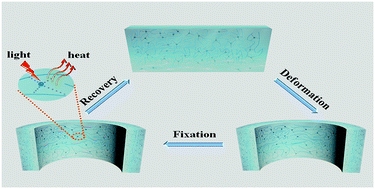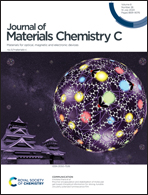Facile fabrication of a CD/PVA composite polymer to access light-responsive shape-memory effects†
Abstract
Stimuli-responsive shape-memory materials are a category of fascinating smart materials, which undergo reversible shape transformation with environmental changes. Among a large number of stimuli-responsive shape-memory materials, light-driven materials have sparked tremendous attention because of their stability, remote operability and environmentally friendly. Herein, we report a novel strategy for the synthesis of a light-responsive shape-memory polymer that is made from carbon dots and polyvinyl alcohol. The as-prepared carbon dots are endowed with good visible light absorption and excellent photothermal conversion, which enable the carbon dot/polyvinyl alcohol composite polymer to serve as a light-responsive shape-memory polymer. The carbon dots not only work as photothermal agents but also offer additional hydrogen bond interaction, which accelerates the shape-memory recovery rate. The results show that the composite polymer can realize shape recovery using relatively low laser power. Most importantly, the as-prepared carbon dot/polyvinyl alcohol composite polymer not only possesses great research potential in different types of fields, such as medical and sensing, but also provides a effective and economic strategy for taking the advantage of light.



 Please wait while we load your content...
Please wait while we load your content...